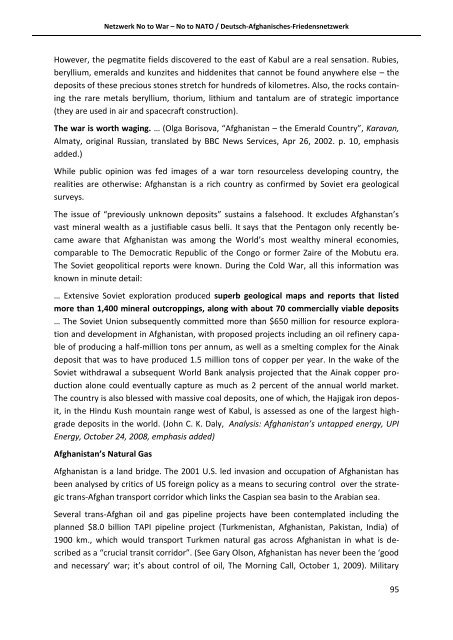Broschüre: Afghanistan zwischen Abzug und Wahlen - NatWiss
Broschüre: Afghanistan zwischen Abzug und Wahlen - NatWiss
Broschüre: Afghanistan zwischen Abzug und Wahlen - NatWiss
Erfolgreiche ePaper selbst erstellen
Machen Sie aus Ihren PDF Publikationen ein blätterbares Flipbook mit unserer einzigartigen Google optimierten e-Paper Software.
Netzwerk No to War – No to NATO / Deutsch-Afghanisches-FriedensnetzwerkHowever, the pegmatite fields discovered to the east of Kabul are a real sensation. Rubies,beryllium, emeralds and kunzites and hiddenites that cannot be fo<strong>und</strong> anywhere else – thedeposits of these precious stones stretch for h<strong>und</strong>reds of kilometres. Also, the rocks containingthe rare metals beryllium, thorium, lithium and tantalum are of strategic importance(they are used in air and spacecraft construction).The war is worth waging. … (Olga Borisova, “<strong>Afghanistan</strong> – the Emerald Country”, Karavan,Almaty, original Russian, translated by BBC News Services, Apr 26, 2002. p. 10, emphasisadded.)While public opinion was fed images of a war torn resourceless developing country, therealities are otherwise: Afghanstan is a rich country as confirmed by Soviet era geologicalsurveys.The issue of “previously unknown deposits” sustains a falsehood. It excludes Afghanstan’svast mineral wealth as a justifiable casus belli. It says that the Pentagon only recently becameaware that <strong>Afghanistan</strong> was among the World’s most wealthy mineral economies,comparable to The Democratic Republic of the Congo or former Zaire of the Mobutu era.The Soviet geopolitical reports were known. During the Cold War, all this information wasknown in minute detail:… Extensive Soviet exploration produced superb geological maps and reports that listedmore than 1,400 mineral outcroppings, along with about 70 commercially viable deposits… The Soviet Union subsequently committed more than $650 million for resource explorationand development in <strong>Afghanistan</strong>, with proposed projects including an oil refinery capableof producing a half-million tons per annum, as well as a smelting complex for the Ainakdeposit that was to have produced 1.5 million tons of copper per year. In the wake of theSoviet withdrawal a subsequent World Bank analysis projected that the Ainak copper productionalone could eventually capture as much as 2 percent of the annual world market.The country is also blessed with massive coal deposits, one of which, the Hajigak iron deposit,in the Hindu Kush mountain range west of Kabul, is assessed as one of the largest highgradedeposits in the world. (John C. K. Daly, Analysis: <strong>Afghanistan</strong>’s untapped energy, UPIEnergy, October 24, 2008, emphasis added)<strong>Afghanistan</strong>’s Natural Gas<strong>Afghanistan</strong> is a land bridge. The 2001 U.S. led invasion and occupation of <strong>Afghanistan</strong> hasbeen analysed by critics of US foreign policy as a means to securing control over the strategictrans-Afghan transport corridor which links the Caspian sea basin to the Arabian sea.Several trans-Afghan oil and gas pipeline projects have been contemplated including theplanned $8.0 billion TAPI pipeline project (Turkmenistan, <strong>Afghanistan</strong>, Pakistan, India) of1900 km., which would transport Turkmen natural gas across <strong>Afghanistan</strong> in what is describedas a “crucial transit corridor”. (See Gary Olson, <strong>Afghanistan</strong> has never been the ‘goodand necessary’ war; it’s about control of oil, The Morning Call, October 1, 2009). Military95


